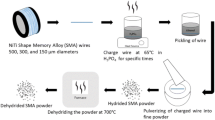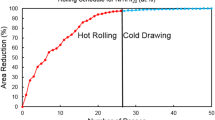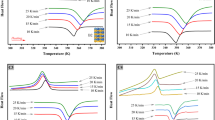Abstract
Ti-rich martensitic NiTi shape memory alloy (SMA) wires of 0.5 mm diameter were tested under hydrogen-charging conditions to reveal the effects on phase transformation. Hydrogen charging was performed by immersion testing for several durations. The SMA wires were characterized by differential scanning calorimetry (DSC), scanning electron microscopy with energy dispersive spectroscopy, and synchrotron radiation X-ray diffraction (SR-XRD) for the the as-received, polished, and hydrogen-charged conditions. The DSC revealed the phase-transformation behavior of the NiTi SMA wires. Single and triple heating/cooling cycles in the DSC show the relationship between hydrogen and temperature on the material. Five distinct peaks (peaks I–V) are observed during heating/cooling in the DSC. Peak I corresponds to the martensite-to-austenite (M → A) transformation. Peaks II, III, and IV are related to hydrogen charging. Peak II appears at about 210–230 °C, while peaks III and IV appear at about 350 and 440 °C, respectively. These higher temperature peaks, peaks II–IV, were observed for the first time for a martensitic NiTi SMA due to the large temperature range covered using the DSC. Only one peak (peak V) appears during cooling and corresponds to the austenite-to-martensite transformation peak. Ex situ and in situ SR-XRD revealed the phases and the crystallographic relationship to peaks I–V in the DSC.












Similar content being viewed by others
References
Otsuka K, Ren X (2005) Physical metallurgy of Ti–Ni-based shape memory alloys. Prog Mater Sci 50:511–678
Jani JM, Leary M, Subic A, Gibson MA (2014) A review of shape memory alloy research, applications and opportunities. Mater Des 56:1078–1113
El Feninat F, Laroche G, Fiset M, Mantovani D (2002) Shape memory materials for biomedical applications. Adv Eng Mater 4:91–104
Benafan O, Brown J, Calkins FT, Kumar P, Stebner AP, Turner TL, Vaidyanathan R, Webster J, Young ML (2014) Shape memory alloy actuator design: CASMART collaborative best practices and case studies. Int J Mech Mater Des 10:1–42
Yokoyama K, Hamada K, Moriyama K, Asaoka K (2001) Degradation and fracture of Ni–Ti superelastic wire in an oral cavity. Biomaterials 22:2257–2262
Wade N, Adachi Y, Hosoi Y (1990) A role of hydrogen in shape memory effect of Ti–Ni alloys. Scr Metall A 24:1051–1055
Wade N, Adachi Y, Hosoi Y (1990) Effect of hydrogen on the shape memory effect and transformation behavior of Ti–Ni alloy. J Jpn Inst Metals 54:525–531 (in Japanese)
Leu CC, Vokoun D, Hu CT (2002) Two-way shape memory effect of TiNi alloys induced by hydrogenation. Metall Mater Trans A 33A:17–23
Horikawa K, Kawabata Y, Kobayashi H (2008) Spontaneous bending of Ni–Ti alloy plates caused by preferential hydrogen absorption. Mater Trans 49:2233–2237
Gao YJ, Qiao WY, Chu JY, He KW (2004) The effect of hydride and martensite on the fracture toughness of TiNi shape memory alloy. Smart Mater Struct 13:24–28
He JY, Gao KW, Su YJ, Qiao LJ, Chu WY (2004) The role of hydride, martensite and atomic hydrogen in hydrogen-induced delayed fracture of TiNi alloy. Mater Sci Eng, A 364:333–338
Ota A, Yazaki Y, Yokoyama K, Sakai J (2009) Hydrogen absorption and thermal desorption behavior of Ni–Ti superelastic alloy immersed in neutral NaCl and NaF solutions under applied potential. Mater Trans 50:1843–1849
Tomita M, Yokoyama K, Sakai J (2008) Effects of potential, temperature and pH on hydrogen absorption and thermal desorption behaviors of Ni–Ti superelastic alloy in 0.9% NaCl solution. Corros Sci 50:2061–2069
Yokoyama K, Watabe S, Hamada K, Sakai J, Asaoka K, Nagumo M (2003) Susceptibility to delayed fracture of Ni–Ti superelastic alloy. Mater Sci Eng A 341:91–97
Yokoyama K, Kaneko K, Moriyama K, Asaoka K, Sakai J, Nagumo M (2003) Hydrogen embrittlement of Ni–Ti superelastic alloy in fluoride solution. J Biomed Mater Res 65A:182–187
Yokoyama K, Ogawa T, Asaoka K, Sakai J, Nagumo M (2003) Degradation of tensile strength of Ni–Ti superelastic alloy due to hydrogen absorption in methanol solution containing hydrochloric acid. Mater Sci Eng, A 360:153–159
Yokoyama K, Eguchi T, Asaoka K, Nagumo M (2004) Effect of constituent phase of Ni–Ti shape memory alloy on susceptibility to hydrogen embrittlement. Mater Sci Eng, A 374:177–183
Yokoyama K, Kaneko K, Ogawa T, Moriyama K, Asaoka K, Sakai J (2005) Hydrogen embrittlement of work-hardened Ni–Ti alloy in fluoride solutions. Biomaterials 26:101–108
Yokoyama K, Ogawa T, Takashima K, Asaoka K, Sakai J (2007) Hydrogen embrittlement of Ni–Ti superelastic alloy aged at room temperature after hydrogen charging. Mater Sci Eng, A 466:106–113
Yokoyama K, Tomita M, Asaoka K, Sakai J (2007) Hydrogen absorption and thermal desorption behaviors of Ni–Ti superelastic alloy subjected to sustained tensile-straining test with hydrogen charging. Scr. Mater 57:393–396
Yokoyama K, Tomita M, Sakai J (2009) Hydrogen embrittlement behavior induced by dynamic martensite transformation of Ni–Ti superelastic alloy. Acta Mater 57:1875–1885
Yokoyama K, Nagaoka A, Sakai J (2012) Effects of the hydrogen absorption conditions on the hydrogen embrittlement behavior of Ni–Ti superelastic alloy. ISIJ Int 52:255–262
Ogawa T, Yokozawa E, Oda T, Maruoka K, Sakai J (2015) Hydrogen embrittlement behavior of Ni–Ti shape memory alloy with different microstructures in acidic fluoride solution. Int J Mech Mater Eng 10:12
Biscarini A, Coluzzi B, Mazzolai G, Tuissi A, Mazzolai FM (2003) Extraordinary high damping of hydrogen-doped NiTi and NiTiCu shape memory alloys. J Alloys Compd 355:52–57
Biscarini A, Campanella R, Coluzzi B, Mazzolai G, Trotta L, Tuissi A, Mazzolai FM (1999) Martensitic transitions and mechanical spectroscopy of Ni50.8Ti49.2 alloy containing hydrogen. Acta Mater 47:4525–4533
Mazzolai FM, Biscarini A, Coluzzi B, Mazzolai G, Villa E, Tuissi A (2007) Low-frequency internal friction of hydrogen-free and hydrogen-doped NiTi alloys. Acta Mater 55:4243–4252
Fan G, Otsuka K, Ren X, Yin F (2008) Twofold role of dislocations in the relaxation behavior of Ti–Ni martensite. Acta Mater 56:632–641
Soubeyroux JL, Fruchart D, Lorthioir G, Ochin P, Colin D (1993) Structural study of the hydrides NiTiHx (x = 1.0 and 1.4). J Alloys Compd 196:127–132
Runciman A, Chen KC, Pelton AR, Trépanier C (2006) Effects of hydrogen on the phases and transition temperatures of NiTi. In: Mitchell MR, Proft J, Berg B (eds) Proceedings of the international conference on shape memory and superelastic technologies May 7–11, Pacific Grove. ASM International, pp 185–196 (2006)
Pelton A, Trépanier C, Gong XY, Wick A, Chen KC (2003) Structural and diffusional effects of hydrogen in TiNi. In: Duerig TW, Pelton A (eds) Proceedings of SMST-2003 monterey
Sheriff J, Pelton AR, Pruitt LA (2005): Hydrogen Effects on Nitinol Fatigue. In: Helmus M Medlin D (eds) Proceedings of ASM materials & processes for medical devices conference. pp 38–43
ASTM F2004-05 (Reapproved 2010) Standard test method for transformation temperature of nickel–titanium alloys by thermal analysis
Schmidt R, Schlereth M, Wipf H, Assmus W, Mullner M (1989) Hydrogen solubility and diffusion in the shape-memory alloy NiTi. J Phys Condens Matter 1:2473–2482
Gamaoun F, Hassine T (2014) Ageing effect and rate dependency of a NiTi shape memory alloy after hydrogen charging. J Alloys Compd 615:680–683
Zeng ZY, Hu CE, Caia LC, Chen XR, Jing FQ (2010) First-principles determination of the structure, elastic constant, phase diagram and thermodynamics of NiTi alloy. Phys B Condens Matter 405:3665–3672
Gamaoun F, Skhiri I, Bouraoui T, Ben Zineb T (2014) Hydrogen effect on the austenite–martensite transformation of the cycled Ni–Ti alloy. J Intell Mater Syst Struct 25:980–988
Racek J, Stora M, Sittner P, Heller L, Kopecek J, Petrenec M (2015) Monitoring tensile fatigue of superelastic NiTi wire in liquids by electrochemical potential. Shape Mem Superelast 1:204–230
Grazulis S, Chateigner D, Downs RT, Yokochi AT, Quiros M, Lutterotti L, Manakova E, Butkus J, Moeck P, Le Bail A (2009) Crystallography Open Database—an open-access collection of crystal structures. J Appl Crystallogr 42:726–729
Lutterotti L, Matthies S, Wenk HR (1999) MAUD: a friendly Java program for material analysis using diffraction. IUCR 21:14–15
Hammersley AP (1997) FIT2D: an introduction and overview. In: European Synchrotron Radiation Facility Internal Report ESRF97HA02T68, 58
Young ML, Almer JD, Lienert U, Daymond MR, Haeffner DR, Dunand DC (2007) Load partitioning between ferrite and cementite during elasto-plastic deformation of an ultrahigh-carbon steel. Acta Mater 55:1999–2011
Frenzel J, George EP, Dlouhy A, Somsen Ch, Wagner MFX, Eggeler G (2010) Influence of Ni on martensitic phase transformations in NiTi shape memory alloys. Acta Mater 58(9):3444–3458
Urch R, Mason N (1978) Absorption of hydrogen by titanium–cobalt and titanium–nickel intermetallic alloys, part 1—experimental results. J Chem Soc Faraday Trans Phys Chem Condens Phases 1:561–577
Ahadi A, Rezaei E (2012) Microstructure and phase transformation behavior of a stress-assisted heat-treated Ti-rich NiTi shape memory alloy. J Mater Eng Perform 21:1806–1812
Paula AS, Mahesh KK, Braz-Fernandes FM (2011) Stability in phase transformation after multiple steps of marforming in Ti-rich Ni–Ti shape memory alloy. J Mater Eng Perform 20:771–775
Nam TH, Kim JH, Choi MS, Lee HW, Kim YW, Im HJ, Ahn JS, Mitani T (2002) Effect of alloy compositions on the R phase transformation in Ti–Ni alloy ribbons fabricated by rapid solidification. J Mater Sci Lett 21:799–801
Liu Y, Blanc M, Tan G, Kim JI, Miyazaki S (2006) Effect of ageing on the transformation behaviour of Ti–49.5 at.% Ni. Mater Sci Eng, A 438:617–621
Murguia SB, Clauser A, Dunn H, Grogg W, Fisher W, Mello L, Snir Y, Brennan R, Young ML (2017) Low pressure hydriding-pulverization-dehydriding method of preparing shape memory alloy powders. In: International conference on martensitic transformation (ICOMAT), Chicago. 07.10.2017 presentation
Kang DB (2006) The bonding of interstitial hydrogen in the NiTi intermetallic compound. Bull Korean Chem Soc 27:2045–2050
Moitra A, Solanki KN, Horstemeyer MF (2011) The location of atomic hydrogen in NiTi alloy: a first principles study. Comput Mater Sci 50:820–823
Holec D, Friák M, Dlouhý A, Neugebauer J (2014) Ab initio study of point defects in NiTi-based alloys. Phys Rev B 89:014110
Acknowledgements
The authors thank Jeff Brown (Dynalloy, Inc.) for supplying Flexinol® wire. YS acknowledges the financial support from the NRCN during his sabbatical. This research used the resources of the Advanced Photon Source, a U.S. Department of Energy (DOE) Office of Science User Facility operated for the DOE Office of Science by Argonne National Laboratory under the Contract No. DE-AC02-06CH11357.
Author information
Authors and Affiliations
Corresponding author
Rights and permissions
About this article
Cite this article
Snir, Y., Carl, M., Ley, N.A. et al. Effects of Hydrogen Charging on the Phase Transformation of Martensitic NiTi Shape Memory Alloy Wires. Shap. Mem. Superelasticity 3, 443–456 (2017). https://doi.org/10.1007/s40830-017-0127-y
Published:
Issue Date:
DOI: https://doi.org/10.1007/s40830-017-0127-y




